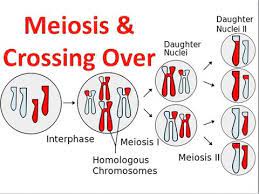In the intricate world of genetics, crossing over is a fundamental process that plays a crucial role in genetic diversity, inheritance, and evolution. This phenomenon occurs during meiosis, the specialized cell division process that produces gametes (sperm and egg cells) in sexually reproducing organisms. Crossing over, also known as genetic recombination, involves the exchange of genetic material between homologous chromosomes. In this article, we will delve into the significance of crossing over in genetics, exploring its mechanisms, consequences, and evolutionary implications.
Understanding Crossing Over:
During meiosis, the genetic material is duplicated, and homologous chromosomes pair up to form tetrads. These tetrads consist of two homologous chromosomes, each containing alleles (variants of genes) for the same traits. Crossing over occurs during the prophase I stage of meiosis, where adjacent chromatids of homologous chromosomes break and exchange segments of DNA. This exchange results in the reshuffling of genetic material between chromosomes, leading to the creation of new combinations of alleles.
Mechanism of Crossing Over:
The process of crossing over is facilitated by protein complexes called synaptonemal complexes, which hold homologous chromosomes together. Enzymes then induce breaks in the DNA strands, allowing the exchange of genetic material between chromatids. The exchanged segments are typically of similar length, ensuring that the total genetic content remains relatively constant. Once the exchange is complete, the broken DNA strands are repaired, resulting in chromosomes with a unique combination of alleles.
Consequences of Crossing Over:
Crossing over leads to the formation of recombinant chromosomes, which contain genetic material derived from both parental chromosomes. This genetic reshuffling enhances genetic diversity within populations by generating novel combinations of alleles. These new combinations contribute to the variability observed in traits such as eye color, height, and susceptibility to diseases. Additionally, crossing over helps in the repair of damaged DNA and ensures the proper segregation of chromosomes during meiosis, thereby reducing the risk of genetic abnormalities.
Significance in Inheritance:
The significance of crossing over in inheritance cannot be overstated. By generating genetic diversity, crossing over increases the chances of offspring inheriting beneficial traits that enhance their survival and reproductive success. Conversely, it also introduces variability that may lead to the expression of deleterious traits. The frequency and location of crossing over events along chromosomes influence the inheritance patterns of specific traits, a concept known as genetic linkage. Understanding these patterns is essential for predicting the inheritance of genetic disorders and for selective breeding in agriculture.
Evolutionary Implications:
Crossing over plays a pivotal role in the evolutionary process by promoting genetic variation within populations. This variation serves as raw material for natural selection, the driving force of evolution. Beneficial genetic variations that arise through crossing over can be favored by natural selection, leading to their increased prevalence in subsequent generations. Conversely, deleterious variations may be eliminated from the population. Over time, the cumulative effects of crossing over and natural selection contribute to the adaptation of organisms to their environments and the divergence of species.
Conclusion:
In conclusion, crossing over is a fundamental process in genetics with profound implications for genetic diversity, inheritance, and evolution. By facilitating the exchange of genetic material between homologous chromosomes, crossing over generates novel combinations of alleles, leading to increased genetic variability within populations. This variability underlies the diversity of traits observed in living organisms and provides the raw material for evolution by natural selection. Thus, crossing over is not just a mechanistic process of genetic recombination but a driving force that shapes the genetic makeup of individuals and populations, ultimately influencing the course of evolution.


No comments yet